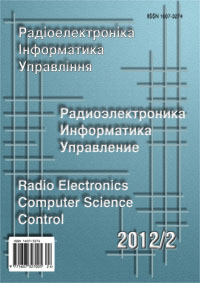COHERENT-PULSE RADAR SIGNALS SPACE-TIME AND TIME-SPACE FILTERING PERFORMANCE EVALUATION
DOI:
https://doi.org/10.15588/1607-3274-2012-2-7Keywords:
radar, electronic counter-countermeasures, clutter and jamming environment, space-time processing, time-space processing.Abstract
The article describes the electronic counter-countermeasures of 36D6 and 80K6 air surveillance radars in jamming and clutter conditions. The algorithm of space-time processing that uses jamming signal cancelling at the first stage and Doppler filtering at the second one has been described. The algorithm of time-space processing that performs main and auxiliary channel signals Doppler filtering at the first stage has also been described. Jammer signal cancelling is performed in frequency domain at the second stage. The efficacy of both systems by simulation using actual interference signals recorded in real life conditions has been determined. The simulation results showed that the space-time filter with use of adaptation inside the coherent processing interval (CPI) is more effective than the same filter that adapts between CPIs. Time-space filtering in jamming and clutter conditions has advantages over space-time filtering. The efficiency of time-space filtering is limited because of Doppler filter magnitude response sidelobes.Downloads
Published
How to Cite
Issue
Section
License
Copyright (c) 2014 A.P. Zalevsky, D.M. Piza, I.S. Presniak, A.S. Sirenko

This work is licensed under a Creative Commons Attribution-ShareAlike 4.0 International License.
Creative Commons Licensing Notifications in the Copyright Notices
The journal allows the authors to hold the copyright without restrictions and to retain publishing rights without restrictions.
The journal allows readers to read, download, copy, distribute, print, search, or link to the full texts of its articles.
The journal allows to reuse and remixing of its content, in accordance with a Creative Commons license СС BY -SA.
Authors who publish with this journal agree to the following terms:
-
Authors retain copyright and grant the journal right of first publication with the work simultaneously licensed under a Creative Commons Attribution License CC BY-SA that allows others to share the work with an acknowledgement of the work's authorship and initial publication in this journal.
-
Authors are able to enter into separate, additional contractual arrangements for the non-exclusive distribution of the journal's published version of the work (e.g., post it to an institutional repository or publish it in a book), with an acknowledgement of its initial publication in this journal.
-
Authors are permitted and encouraged to post their work online (e.g., in institutional repositories or on their website) prior to and during the submission process, as it can lead to productive exchanges, as well as earlier and greater citation of published work.






